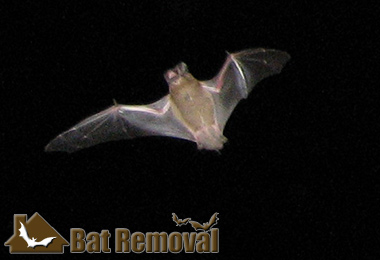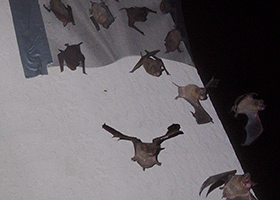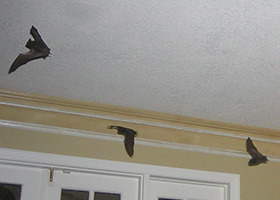Saint Paul Bat Removal
Welcome to Saint Paul Bat Removal! We are Minnesota bat removal specialists. It is important to know that bats are protected by Minnesota law, and are beneficial animals to have in the environment. We do not kill any bats during our bat removal process. Never hire a pest control company or anyone who says they are a Saint Paul bat exterminator. For correct and effective bat removal, you want a company that specializes in humane bat colony extraction. Our process is not only the only legal method in Minnesota, but it is the most effective. We have a 100% success rate in our bat control process. We perform our industry-best 32-point inspection of your house or building, and seal shut all bat entry holes down to 1/4 inch as part of the removal process, during which we remove the colony via special one-way exclusion devices specific to your architecture. Once all bats are safely out, we permanenetly bat-proof the structure. We also provide guano (bat droppings) removal and decon. Click on our Saint Paul Bat Control Prices page to find out more about our prices for bat control work. We work 24/7/365, and would love to talk to you about your bat problem. Call us any time at 651-321-5187 to discuss it, discuss our pricing, and if you wish, set up an appointment at your convenience, often same-day.

Saint Paul Building and Attic Inspections

No-kill Minnesota Bat Extraction

Guano Cleanouts - Serving all of Minnesota
Call 24/7 to discuss your bat problem.
Same-day or next-day appointments.
32-point inspection of your property.
Written estimates for bat removal project.
Fully state licensed and insured.
Residential and commercial service
100% no-kill Saint Paul bat extraction
Complete bat-proofing of your building
Compliance with all Minnesota, federal laws
Guano removal and attic decontamination
Our Service Range - 651-321-5187



How Bats Are Using Their Echolocation Ability
Bats are interesting creatures. They are among the few creatures that can use sound to navigate on their surroundings. This is an ability known as echolocation. Around half of the species of bats will heavily rely on their echolocation to determine the location of their prey and avoid colliding on solid surface. They may also use this to look for an excellent roosting spot inside the cave.
What is Echolocation?
Echolocation refers to the method that actively uses Sound Navigation and Ranging (SONAR). The bats will be using this together with their physiological adaptation as well as their physical features. This combination allows the bats to navigate even in a pitch black environment.
How Bats Are Producing Sound
Most species of bats will produce the sound of echolocation through larynx contraction. There are also bats that will produce a clicking sound using their tongues. The noise will then be released through the mouth of the animal. However, there are also species of bats such as the Hipposideridae and the Rhinolophidae that will emanate the sound through their nostrils. Their nostrils have a feature that magnify the intensity of the sound.
The Ultrasonic Sounds of Echolocations
The calls made during the echolocation are generally ultrasonic. This means that the frequency may range from 20 KHz-200 KHz that is beyond the human's hearing capacity. However, there are also instances when the clicks will be audible, like on the case of Spotted Bat. The calls that they will produce will resemble the sound of the two pebbles that are hitting each other. The calls can be determined through their duration, strength, and frequency.
Loudness and Pitch of the Echolocation
With regards to the pitch of their echolocation, the bats can produce it in FM (Frequently Modulation) and CF (Constant Frequency). Some bats can also produce noise in varying frequencies. The sound that was released on lower frequency will be able to travel longer. However, if the bats will need to gather more information, it should be in the higher frequencies. Some of the information that can be collected includes the direction, position, location, speed, size, and range.
On loudness, the calls can be as loud as 120dB or may be low at 50dB. The loudness can sometime be damaging to our ear. One bat that is known to produce high calls would be the Little Brown bats. Fortunately, the sound that they release cannot be heard by the human ear.
The Ear Structure
The ear structure of the bat is particularly designed to the sound frequency that is being emitted by the bat. The receptors found in their ear will make them extremely sensitive to the changes in frequency. There are species of bats that can determine even a slight change in frequency. For their ears to not receive any damage from the ultrasonic sound, they have an ear muscle known as stapedius that will contract and will reduce their sensitivity.
If you want to understand the complexity and technicality of the bat's echolocation, you will have to learn about the nature and the behavior of the bats.

